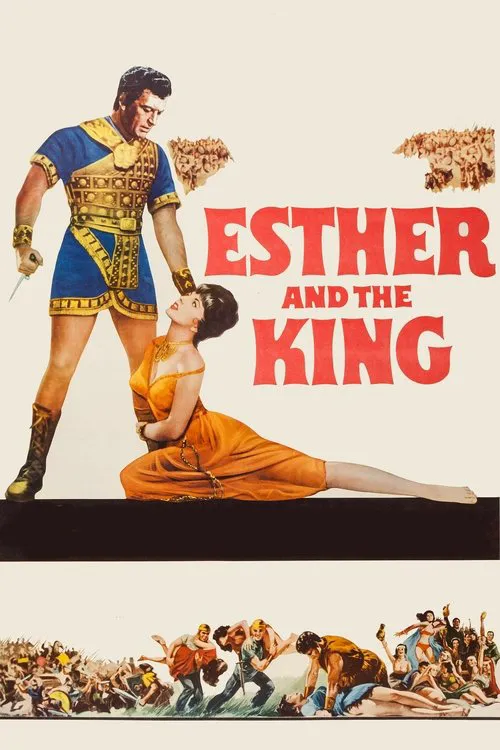Esther and the King

Plot
In the ancient Persian Empire, King Ahasuerus, also known as Xerxes I, is a powerful and wealthy ruler who has recently lost his beloved wife, Queen Vashti, after she failed to heed his command to unveil herself before a grand assembly of courtiers. Following her demise, Ahasuerus becomes consumed by grief and begins to look for a new queen to share his throne and heart. During an extravagant banquet held in Susa, the capital of the Persian Empire, Ahasuerus is immediately drawn to a beautiful young Jewish woman named Esther, who has been taken under the care of her cousin, Mordecai, a respected and wise Jewish leader. Despite initial reservations from Mordecai, Esther volunteers to meet the king and introduce herself, and Ahasuerus is impressed by her beauty, charm, and poise. After a brief courtship, the king proposes to Esther, and she accepts. Mordecai is overjoyed at the prospect of his cousin becoming the new queen, but he cautions Esther to conceal her Jewish heritage, knowing that this might put her in jeopardy should it become known among the king's courtiers. Meanwhile, a sinister figure emerges in the form of Haman, the king's evil and cunning minister. Born into a family of nobles, Haman seeks to increase his power and influence within the royal court by any means necessary. He is also driven by a deep-seated hatred for the Jewish people, whom he sees as a threat to the empire's unity and stability. Haman becomes enraged upon learning that Mordecai, Esther's cousin and a fellow Jew, has refused to bow down to him as is customary when meeting nobles of higher rank. Haman reports this perceived snub to the king, accusing Mordecai of treason and plotting against the state. Ahasuerus, still reeling from his wife's death and seeking revenge against those who failed to heed his commands, orders the execution of Mordecai without conducting a proper inquiry or even consulting with anyone. Unaware of Esther's connection to the Jewish people, the king unwittingly sets in motion a sequence of catastrophic events that threaten the lives of his new bride and her people. As Esther rises through the ranks to become the new queen, Haman's power and influence grow exponentially, fueled by his hatred for the Jews. He convinces Ahasuerus to issue a decree ordering the destruction of the entire Jewish population throughout the empire, with the sole exception being the royal family and their attendants. Mordecai, however, remains steadfast in his faith and loyalty to his people, and he secretly alerts Esther to the impending doom facing the Jewish people. In a bold and courageous move, Esther appeals to the king, begging him to rescind the decree and spare the lives of her people. Ahasuerus, still struggling to overcome the trauma of his past, is initially resistant to Esther's plea. However, after learning that she is indeed a Jew, he is overcome with remorse and anger towards Haman for concealing the truth from him. Haman, realizing that his days are numbered, attempts to persuade the king to execute Esther, accusing her of orchestrating a plot against him. However, before the king can carry out Haman's request, a gallows has been erected for Haman himself, in accordance with the law for crimes of treason, as he had plotted to kill not just Mordecai, but the king who Haman had seen as an obstacle to his own ambitions and plans to annihilate the Jews. Confronted with this shocking revelation, Ahasuerus orders the execution of Haman, while also issuing a new decree that allows the Jewish people to defend themselves against their enemies. The Persian Empire is thus saved, and the Jewish people celebrate the salvation of Esther, who emerges as a true hero and champion of her people. In the end, Esther and Ahasuerus are reunited, their love strengthened by the challenges they faced. Mordecai is elevated to an elite group of advisors to the king, and the empire is forever changed as a result of Esther's bravery and selflessness.
Reviews
Recommendations




